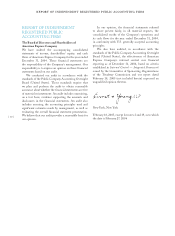American Express 2006 Annual Report Download - page 63
Download and view the complete annual report
Please find page 63 of the 2006 American Express annual report below. You can navigate through the pages in the report by either clicking on the pages listed below, or by using the keyword search tool below to find specific information within the annual report. [ 61 ]
2006 fi nancial review
american express company
cards-in-force, cash advances on proprietary cards and
certain insurance fees charged on proprietary cards.
Non-proprietary billed business represents the charges
through the Company’s global network on cards issued
by the Company’s network partners.
Card acquisition — Primarily represents the issuance of
new cards to either new or existing cardmembers through
marketing and promotion efforts.
Cardmember — The individual holder of an issued
American Express branded charge or credit card.
Cardmember lending finance charge revenue, net of interest
— Represents the net revenue earned on outstanding
cardmember loans. Cardmember lending finance charges
are assessed using the average daily balance method.
They are recognized based upon the principal amount
outstanding in accordance with the terms of the applicable
account agreement until the outstanding balance is paid
or written-off. Cardmember lending finance charges
are presented net of the interest expense incurred by the
Company to finance lending receivables.
Cardmember loans — Represents the outstanding amount
due from cardmembers for charges made on their
American Express credit cards, as well as any interest
charges and card-related fees. Cardmember loans also
include balances with extended payment terms on certain
charge card products.
Cardmember receivables — Represents the outstanding
amount due from cardmembers for charges made on
their American Express charge cards as well as any card-
related fees.
Charge cards — Represents cards that carry no pre-set
spending limits and are primarily designed as a method
of payment and not as a means of financing purchases.
Cardmembers generally must pay the full amount
billed each month. No finance charges are assessed on
charge cards.
Credit cards — Represents cards that have a range of
revolving payment terms, grace periods, and rate and
fee structures.
Discount revenue — Represents revenue earned from
fees charged to merchants with whom the Company has
entered into a card acceptance agreement for processing
cardmember transactions. The discount fee generally is
deducted from the Company’s payment reimbursing the
merchant for cardmember purchases.
Interest-only strip — Interest-only strips are generated
from U.S. Card Services’ securitization activity and
are a form of retained interest held by the Company in
the securitization. This financial instrument represents
the present value of estimated future “excess spread”
expected to be generated by the securitized assets over
the estimated life of those assets. Excess spread is the
net positive cash flow from interest and fee collections
allocated to the third-party investors’ interests in the
securitization after deducting the interest paid on the
investor certificates, credit losses, contractual servicing
fees, and other expenses.
Merchant acquisition — Represents the signing of
merchants to accept American Express-branded charge
and credit cards.
Net card fees — Represents the card membership fees
earned during the period. These fees are recognized
as revenue over the covered card membership period
(typically one year), net of provision for projected
refunds for cancellation of card membership. Beginning
prospectively as of July 1, 2006, certain card acquisition-
related costs were reclassified from other expenses to a
reduction in net card fees over the membership period
covered by the card fee.
Net loss ratio — Represents the ratio of write offs, net
of recoveries on cardmember receivables expressed as a
percentage of the total charge card volume.
Net write-off rate — Represents the amount of loans
written off, net of recoveries as a percentage of the
average loan balance during the period.
Return on average equity — Computed on a trailing 12-
month basis using total shareholders’ equity as included
in the Consolidated Financial Statements prepared in
accordance with U.S. GAAP.
Return on segment capital — Computed on a trailing 12-
month basis using segment income and equity capital
allocated to segments based upon specific business
operational needs, risk measures, and regulatory
capital requirements.
























